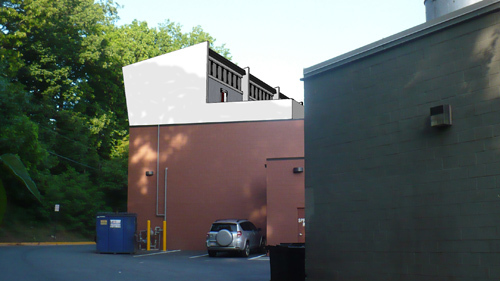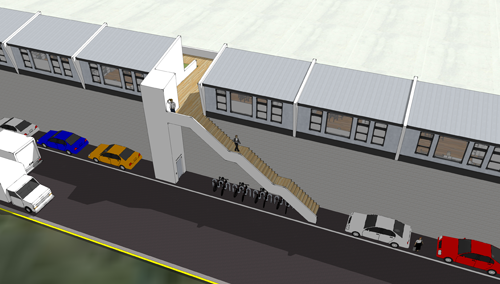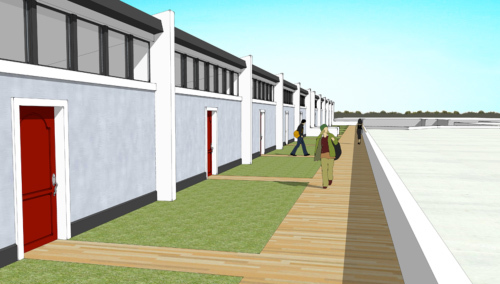Could rooftop apartments transform suburban retail?
Suburban retail areas are redeveloping into mixed use neighborhoods all over the DC region. Usually redevelopment means mid-rises replace single-story retail, but could another model work? What if retail strips added rooftop apartments?
From more livable communities to less congested highways, mixed-use development has many benefits, and is in high demand. In places where market demand or zoning regulations prohibit larger scale mid-rises, maybe innovative design can help bring those benefits too.
Imagine a row of small apartments added to a big box store’s roof. Let’s explore how that might work, using the Safeway supermarket in Seven Corners as a test subject.
Since the building is so wide, a narrow second story near the back would be completely invisible from the front. Thus, the building can accommodate apartments with minimal to no effect on the store’s appearance.
What could fit?
The rear wall of this Safeway is long enough to fit 10 apartments, each 25 feet long, with a gap in the middle to provide access to stairs. The paved area behind the store is wide enough to accommodate stairs and a narrow parking lane for residents, with enough room left over for two vehicles to pass each other.
A terrace in front of the apartments acts as a walkway, providing access to each unit. Rows of windows high on the front wall bring sunlight in without compromising privacy or subjecting residents to views of the store’s roof.
Inside, each unit is a 300 square foot efficiency style apartment.
These apartments may not be luxurious, but maybe that’s OK. Given rising demand for mixed-use living, apartments like these could provide scarce affordable housing to tenants who want to walk to shopping areas. Perhaps retail workers at the very stores below might be able to live here.
Meanwhile, nearly invisible apartments atop strip malls might conceivably face less opposition from surrounding communities than large new buildings. Or maybe not; that’s hard to predict. But new housing has to go somewhere, and it’s better if we can fit more of it in existing communities. Maybe this is a way to do that.
Is this actually realistic?
There are clearly challenges to making an idea like this work.
First, the structural challenge. Since the roof wasn’t designed to support a second story, the building would likely need structural reinforcement. That’s unlikely to happen in a functioning supermarket that’s open to customers. But it may be practical during renovations, for adaptive reuse, or in new buildings.
Second, the regulatory challenge. Many suburban retail strips are retail-only because that’s what the zoning allows. Since it often takes years to go through the difficult process of getting zoning approval for mixed-use, it’s often only worth developers’ trouble for large projects.
Finally, the developer challenge. Developers often specialize in one type of project. Toll Brothers builds suburban houses, Abdo builds urban mixed-use mid-rises, Macerich specializes in shopping malls. It would likely take a special case for a suburban retail developer to take on apartments, or an apartment developer to build a big box.
But people used to cite similar challenges as impediments to New Urbanism, and it’s booming. Where there’s a will, there’s a way.
And there could be a will. Demand for convenient mixed-use living keeps growing, while our cities keep getting more and more expensive. Something is going to have to give. This idea could provide affordable housing that’s walkable to convenient destinations.
It just takes a little creativity. And, maybe, a small scale pilot project or two.





